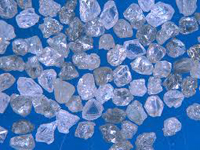
Natural Diamond manufacturers and distributors of High Pressure High Temperature (HPHT) are claiming an opportunity for their small, specialized niche advocates of HPHT-processed natural diamonds are working to change the perception of their product.
Natural diamond manufacturers and distributors of High Pressure High Temperature (HPHT) are claiming an opportunity for their small, specialized niche. Not to be confused with treatments or synthetics, advocates of HPHT-processed natural diamonds are working to change the perception of their product.

There are two types of HPHT diamonds, explained Gerry Hauser, CEO of Hadar Diamonds, a distributor of HPHT natural diamonds. The first is a lab-grown, or synthetic diamond that is created using HPHT by simulating the conditions by which a natural diamond is produced. The second is a natural diamond that uses HPHT to change the brownish color of the stone to achieve its full potential.
"We recognized that if we could put the diamond back into that heat and pressure scenario, the diamond could be de-stressed," he explained. "In a controlled environment it can relax and go back to its original color."
Lack of Awareness
Both Hauser and Kaplan urge retailers to embrace these goods as an opportunity to sell a high-quality diamond for a significantly lower price than the unprocessed natural equivalent. They estimate that a consumer can save 20 percent to 30 percent by buying an HPHT-processed natural diamond compared to the equivalent unprocessed natural stone. However, Kaplan admitted that very few consumers are aware of the option to purchase these goods and most retailers do not know much about them. Part of the reason has been the industry's reluctance to market HPHT natural diamonds.
Another reason for their slow market penetration is that there's a limited supply. These diamonds come from type IIa rough, which are very rare in nature. Although the great majority of type IIa's are typically pure internally, it is only those that are of the highest quality that are chosen to go through the process. As a result, Kaplan estimates that the amount of type IIa diamonds that can be processed account for less than 1 percent of all natural diamonds.
Disclosure & Detection
While HPHT-processed natural diamonds contain the same materials and characteristics as unprocessed diamonds, there remain strict guidelines to disclose these goods as HPHT stones and for the laboratories to clearly label them as such on their certificates.
Furthermore, there are concerns about non-disclosed HPHT-processed diamonds being submitted for grading as natural diamonds, particularly since these challenges have become prevalent with regards to Chemical Vapor Deposition (CVD) synthetic diamonds in the past two years.
Market Acceptance
In terms of classifications, mined diamonds are either processed or unprocessed naturals, while treated diamonds are not considered natural, he explained. Furthermore, synthetic lab-grown diamonds are neither natural nor mined diamonds. Kaplan is confident that with the correct educational programs, HPHT natural diamonds will eventually become an accepted product like any other natural mined diamond.
Still, HPHT-processed natural diamonds need to be differentiated from unprocessed natural diamonds as well as from HPHT synthetics, CVD synthetics and treated diamonds. As with those processes, there needs to be effective detection, disclosure and documentation for these goods. But with the right structures in place, there's no reason that consumers shouldn't consider these diamonds as a valuable alternative to unprocessed natural diamonds. So too should jewelers embrace the opportunity that these stones present to the market for now.